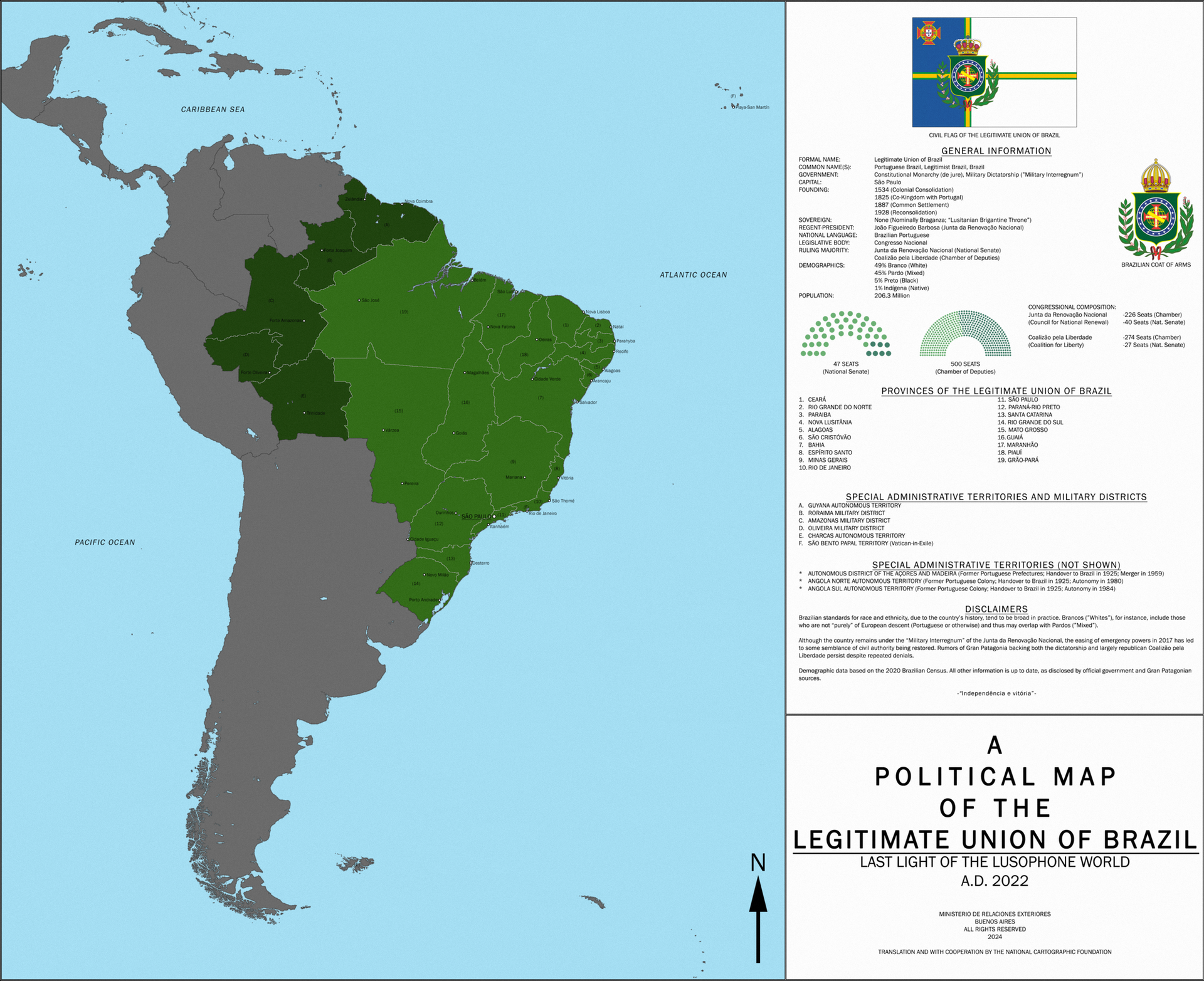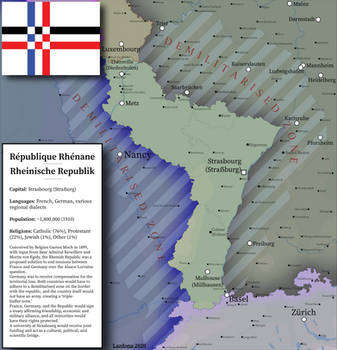Deviation Actions
Description
The Legitimate Union of Brazil, more commonly known as either Portuguese Brazil, Legitimist Brazil or simply Brazil, has traditionally been one of the leading nations of South America. Nominally a constitutional monarchy under the Braganza dynasty, the so-called Lusitanian Brigantine Throne has formally remained empty since 1992. In reality, it remains a dictatorship under a"Military Interregnum," presided over by Regent-President João Figueiredo Barbosa since 2001. While its standing in the Free World may remain firm on paper only, despite being one of the founding members of the Assembly of the Free World, this realm's clout and prestige remain undeniable.
A Brief History of Portuguese Brazil
While the ancestors of today's Indígenas, particularly the Taino, have lived in the vicinity of what would become the Legitimate Union of Brazil, the country's origins are tied with Portugal's exploration of the New World. In 1534, the myriad budding colonies and outposts along the coast were consolidated under a more centralized authority. Over the next several decades, colonists and slaves alike began arriving in growing numbers, while missionaries and groups of bandeirantes explored more of the unknown interior. Though such ventures at first didn't quite match with the Austrian Habsburgs further north or the Spanish efforts elsewhere, time would be on their side.
As the Portuguese invested ever more on their South American territories over the next 200 years, a complex relationship with the homeland emerged. More of the colonists, who grew increasingly prosperous from produce like sugarcane and eventually gold, had begun seeing themselves as "Brazilian." Meanwhile, mutual co-existence and intermingling with the Indígenas (initially tolerated to ensure order) grew increasingly acceptable, though similar trends involving Pretos gradually led to concerns over matters like slavery as an institution. Although such issues would be the cause of several disputes and more than a handful of revolts (including the so-called Quilombo War of 1768), a series of hard-won compromises helped set colonial society on a path to not only the formal abolition of slavery in 1799 or greater ethnic integration. But in the process, it also fostered ties with New Austria and more importantly, raised the colony's standing in the eyes of Portugal itself.
Brazil's ascension as a Co-Kingdom in 1825 would spur a period of expansion and development. More immigrants and settlers, including those from outside Portugal, flocked in with new industries and technologies, while further contributing to the nascent Brazilian national consciousness. Within a generation, the realm came to be more than firm enough to challenge the states that emerged from the wars of independence against Spain, rivaling the republican upstarts of what is now Gran Patagonia. It wasn't long, however, before this rise fostered a growing sense of Lusophone solidarity and loyalty. By the dawn of the 20th Century, Brazil and Portugal increasingly saw each other as equals more than anything else. From what's known, there were even plans to formalize a genuine union between the two, which had started with the Common Settlement of 1887, that would have solidified the ruling Braganzas' peaceful hegemony with popular acclaim.
The Terror brought such dreams to a halt. Despite the valiant efforts by the Portuguese, by 1925 what remained of the Kingdom's territories were handed over to Brazil, as the old homeland crumbled before the Collectivists. Amidst the chaos, the heir-apparent Prince Afonso assumed control in São Paulo in 1926, his quick actions decisive in helping preserve the realm in the face of seeming destruction. When it became evident, however, that Portugal itself was beyond saving, he reluctantly oversaw the formal Reconsolidation in 1928 and was crowned King Afonso VII. His reign saw his country through the next few decades as one of the most dominant of the Free Nations. Though gradually, conditions were unraveling.
While his efforts to ensure both Portuguese Brazil's survival and that of the Lusitanian Brigandine Throne were initially successful, these would have unintended consequences. Even with New Austrian support, the Brazilians found themselves harder pressed by the 1950s to sustain efforts to directly contain the Collectivist Internationale's machinations along its extensive borders. This wasn't helped by the growing economic and political clout of its long-time rival Gran Patagonia, especially as it became more successful in promoting republicanism as an alternative. Meanwhile, the special mandates given to the Forças Armadas Brasileiras (originally meant to help quell Collectivist influence) over time allowed it to establish "Military Districts" and gain greater say in political affairs. While the monarchy and civil government tried to maintain a balance, which for a time work, it fell apart during the Belem Incident of 1992.
In a heinous bombing instigated by Collectivist sleeper agents, King Pedro V, along with immediate members of the royal family and hundreds of bystanders, was killed while on a landmark tour across the realm. While the fractured nobility and what remained of the Braganza line bickered over the line of succession, however, military elements led by General Fernando Silva e Oliveira (himself a descendant of a family of military commanders) invoked "emergency powers" and, as the first Regent-President, formed what would become the Junta. It wouldn't be until 2017 that some of the excesses, including the suspension of elections and curtailment of many political freedoms, were lifted.
- “Atlas Sans Frontieres: The Gaspereau-Thomson Guide to the New World.” Loyalist Canada. 2023.
The Californias: mdc01957.deviantart.com/art/Th…
Kuba and its Neighbours: mdc01957.deviantart.com/art/Ku…
Loyalist Canada: mdc01957.deviantart.com/art/Lo…
Western Europe c.2015: mdc01957.deviantart.com/art/We…



































